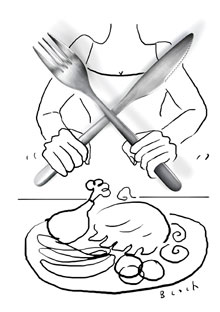
Slash sugar and salt intake just by reading.
Labels, that is. You'll be shocked at how many foods—ketchup, spaghetti sauce, peanut butter, juices, cereals—are loaded with hidden sugar (a.k.a. glucose, fructose, sucrose, and the ubiquitous high-fructose corn syrup). The same goes for sodium: Abandon canned chicken noodle soup (a whopping 1,780 milligrams of salt per cup) for low-sodium minestrone or vegetable (a mere 290).
Also take a minute to gauge the number of servings per container, this helps you limit how much you should consume.
Drink yourself skinnier.
There are about 144 calories in six ounces of white wine, 136 in 12 ounces of soda, 380 in a mocha Frappuccino( a devilish fav of mine), and—caramba!—as many as 740 in a frozen margarita. Make water or seltzer your beverage of choice. If you must go with someone and SHARE. I almost always go to Starbucks and share my tall decaf frapuccino with my girls. Sometimes when I have a sweet craving, an 2oz is enough to satisfy it.
Don't cut out, cut back.
You can have your cake and eat it, too—on weekends. 200 fewer calories a day translates to nearly 2 pounds a month. So what, you ask? That's around 20 pounds a year, that's what. Enjoy the way weight loss creeps up on you—the same way weight gain did. But increase the amount of fruits and vegetables you eat—without frying, buttering, or drenching them in oil.
Whatever exercise you're doing, do more.
You say you're too out of shape, too busy, too tired, too poor? Sisters, observe your feet. Already attached, always available, and free. Use them to walk to work (and eventually up the stairs), around the block at lunch, and down the hall when you need to talk to a colleague instead of using the phone or e-mail. Walk from the farthest parking place at the mall, and walk on the weekend with friends and family. Walk around the house while you're on the phone.
For me, I never settle into the couch for up to 2hrs( watching a movie/ using my laptop) without doing 20leg lifts.
Pop a pill.
Take a basic, one-a-day multivitamin (with 400 micrograms of folic acid if you're of childbearing age). Ditto a calcium supplement; we need 1,000 milligrams a day until menopause and 1,200 thereafter (ask your doctor if she thinks it should be more and when to start annual bone density scans). Add B12 if you're over 50.Make sure you are getting adequate Calcium & Vitamin D.
Search Charleston, SC Properties Online



